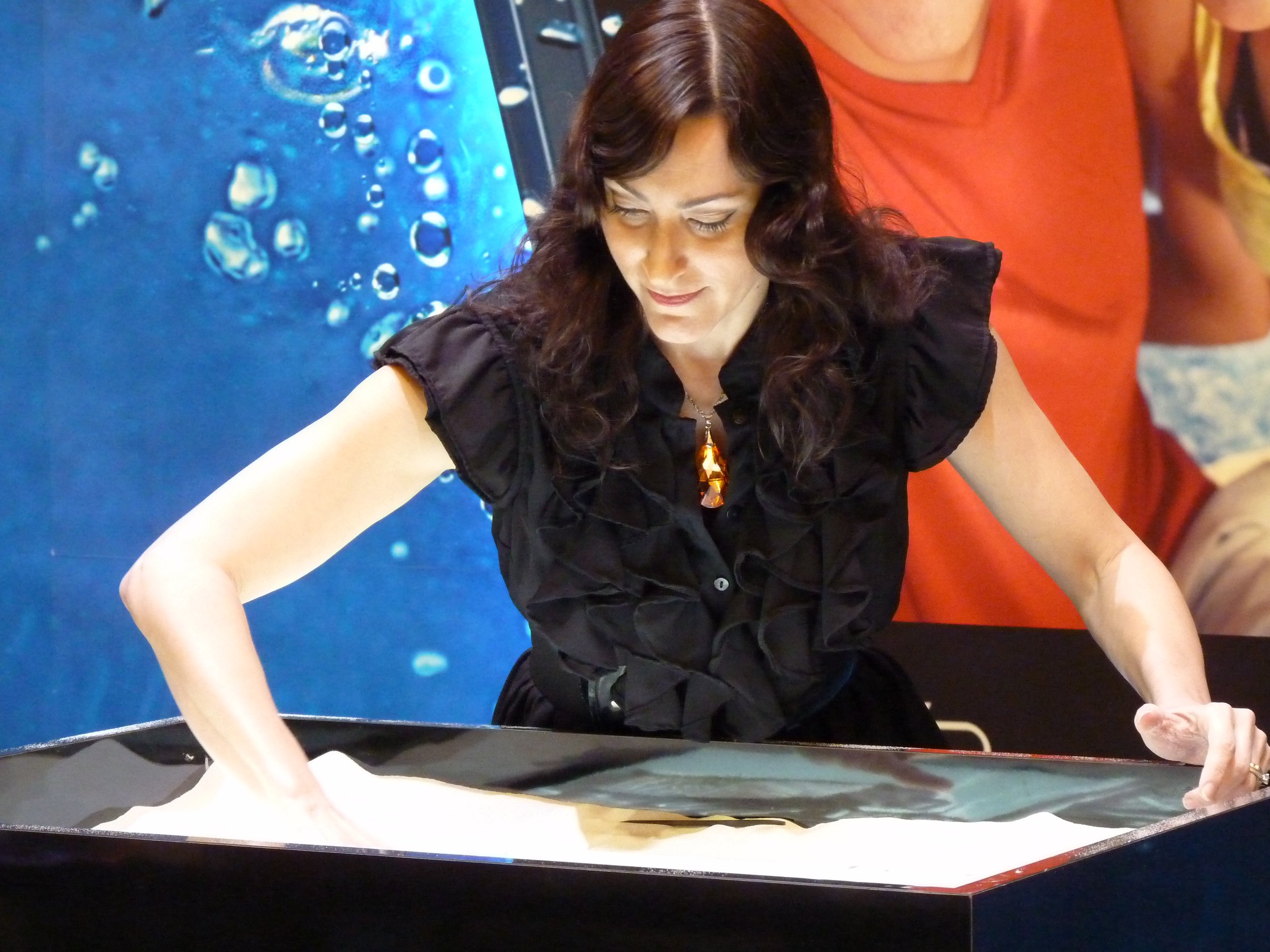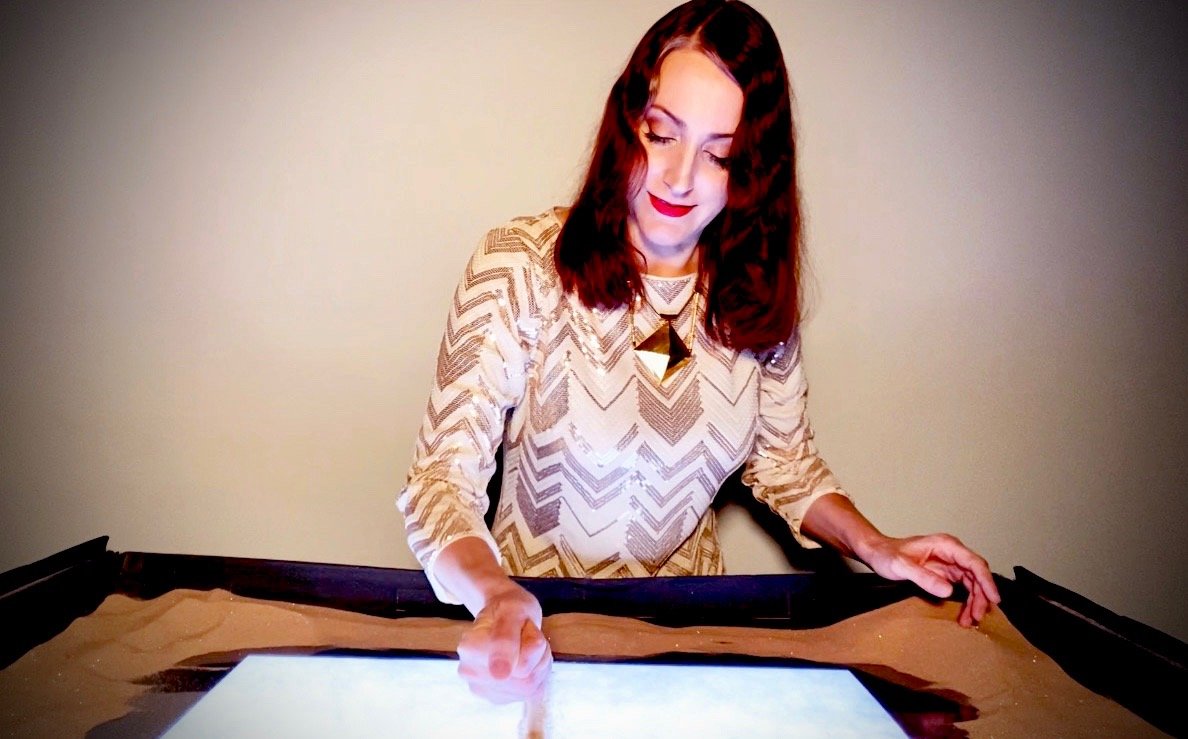Lanzel is a freelance artist of various art forms. One of her specialties is performing sand animation, a performance that requires weeks of preparation for a five minute performance.
Lanzel discovered sand animation when she became interested in Buddhist philosophy. In 2004, a friend and fellow artist sent her a video of Ferenc Cakó, a Hungarian film artist, who invented the live art form.
On a Tumblr blog created by Cakó fans, the biography states that he started doing sand animation in 1988, along with clay animation, which won him a Gold Palm in Cannes that year. In 1996, Cakó performed sand animation live and with music for the first time.
Sand animation, or sand art, is performed in total darkness using a sand box with a light. A camera projects the image in the sand box onto the projector screen, showing the audience a variety of images. The only tools used are sand and the artist’s own two hands. The animation is normally accompanied by music.
“I just fell in love,” she said. “I was just so drawn to it, and I could actually picture myself up there doing it.”
Before she was a sand artist, Lanzel painted murals. Born in Wisconsin to visual artist parents, she was exposed to various forms of visual art such as drawing, painting, and ceramics. She moved to New York when she was 20 years old and began her career as a professional artist. She worked in the art department of Unique Clothing Warehouse, a center for fashion in the 1980’s. She became the Art Director until the store finally shut down in 1991. She then became a freelance mural artist.
“I’ve been an artist all my life,” she said.
She later began working for Silver Hill Atelier, a mural painting company in New York, where she had the chance to travel nationally and internationally and paint murals for various places and companies. Her works were featured in restaurants, casinos, amusement parks, and even residential homes. She even worked on murals for Godiva Chocolatier and two Disneyland parks: Disneyland Tokyo and Disneyland Hong Kong.
“I was doing really well as a mural painter,” she said.
Lanzel also had a brief history in performing in a cabaret show.
“At night, I was a showgirl,” she fondly recalled.
The emergence of digital technology eventually affected the business of mural painters, including Lanzel. With art being done digitally in this new age, she wanted to try something new and different. This is when sand animation entered her life once more in 2010.
“And then I remembered this art form and how much I loved it,” she said. “So I thought ‘let me give it a try and see if it’s something I can do for a living.’”
So, in her own little studio, Lanzel built her own wooden sand box attached to a light box and a camera. She taught herself the art through experimentation with different styles and techniques. She was a master by the time 2011 came around and began posting videos of herself performing on Youtube. It was a perfect match.
“The sand art brought together my art work and my performance into one thing,” she said.
Within weeks of posting her first video, Cirque du Soleil, one of the biggest theatrical producers in the world of circus arts and street entertainment, found her video. The company invited her to perform for the opening party of Zarkana, Cirque du Soleil’s famous acrobatic show.
“That was my first gig,” she said. “I was really nervous, especially because it was Cirque du Soleil.”
Performing for a large crowd was not a first time experience for Lanzel, but nonetheless, it was a wonderful feeling. One video was all it took for her career to take off.
“I felt so lucky,” she said.
Lanzel said that there are only a handful of professional performance artists for sand animation in the world who can perform live. Two can be found in the United States. Lanzel is one of them.
“It’s quite rare,” she said. “You can watch videos online, but it’s very rare to see an actual live performance.”
Back in 2012, sand animation was featured on NBC’s “America’s Got Talent” where an artist from Richmond, Joe Castillo, made it to the semi-finals with his live performance. Another sand artist, Kseniya Simonova, was also on “Got Talent” in Ukraine back in 2009, where she won the competition after performing sand animation live.
Sand animation is not simply drawing pictures in the sand as you would at the beach. According to Lanzel, it is “a very meditative art form.”
“It requires me to really go deeply within myself to kind of conjure the story,” she said. “I have to be able to not only create a nice image, that image also has to be able to transform into another scene.”
In the case of her “Valentine" piece, it started off with a perfect night in the city, calm and romantic. The final piece was not this calm, romantic city scene, but of the two lovers standing on top of the world. Lanzel managed to create the story of the two lovers without the need for words, only sand.
Lanzel remembers performing at a convention sponsored by Silpada, a jewelry company. This happens to be one of her most memorable performances in her career as a sand artist.
“It was there that I received my first standing ovation,” she said proudly.
The experience was unbelievable to Lanzel.
“I can’t begin to express how good that feels for an artist,” she said. “Because normally, we’re just working alone in our studio. We don’t get to have that kind of recognition, so for an artist like me, a visual artist, it’s very rare to be able to experience getting a standing ovation.”
Lanzel’s pieces and performances vary, often depending on her clients’ requests or suggestions.
“I try to make the pieces emotional,” she said. “Because that’s what really grabs people.”
Nature scenes are common in her pieces.
“There’s nothing more beautiful than nature,” she said.
Because of the amount of time for her come up with full piece, Lanzel only take on a few custom pieces per month.
“It takes me about two or three weeks to create a custom animation,” she said. “I like to be able to give my full attention to each project.”
In addition, Lanzel also has her ambient performances, pieces she creates herself. Her ambient performances are a mix of the different pieces she performs in the videos found on her Youtube page. She combines these to create one big story, about 20 minutes long.
“It’s kind of like a film,” she said.
Sometimes, the music is pre-recorded. Sometimes, it’s performed live by a band. But the music Lanzel chooses for her performance, as well as the images she animates, all convey a message.
“There’s a lot of back and forth between the music and the artwork,” she said. “They go together. I can’t imagine sand art without music. The music takes it to a more dramatic level.”
Lanzel currently resides in New York City. She still travels around the country and around the world, performing and spreading her art to a wide variety of audiences. In addition to performing for top companies like Google, Geobeats, and Fusion Productions, she also gets invited to perform at festivals, weddings, and even dinner parties. Sand animation is an art form that can be integrated and performed anywhere. Lanzel calls it an “ephemeral art form.”
“It only happens in the moment,” she said. “I spend about two weeks of my time coming up with a new piece, only to be performed once, usually. So whoever is in that room, gets to see that effort. It’s a very special thing.”


















